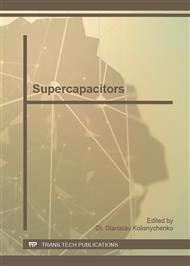p.431
p.435
p.439
p.444
p.448
p.452
p.457
p.461
p.466
Preparation and Electrochemical Characterization of Li-Ion Supercapacitor
Abstract:
A new type of Li-ion supercapacitor was fabracatied with activated carbon as cathode and graphite pre-intercalated Li ion as anode. The electrochemical characterization was also conducted with cyclic voltammetry and AC impedance methods. By this unique cell design , the capacitance of Li-ion supercapacitor keep the same level to double elecric layer supercapacitor ,But the voltage window of supercapacitor can be enhanced from 2.5V to 4.2V.So the energy density of Li-ion supercapacitor can be enhanced 4 times of common carbon-based supacapacitor. There is above 99% capacitance retention for Li ion supercapacitor after 200 cycles at 200mA discharge current. A pure capacitance behavior can be found at the frequency below the knee in its AC impedance spectroscopy.
Info:
Periodical:
Pages:
448-451
Citation:
Online since:
February 2012
Price:
Сopyright:
© 2012 Trans Tech Publications Ltd. All Rights Reserved
Share:
Citation:



